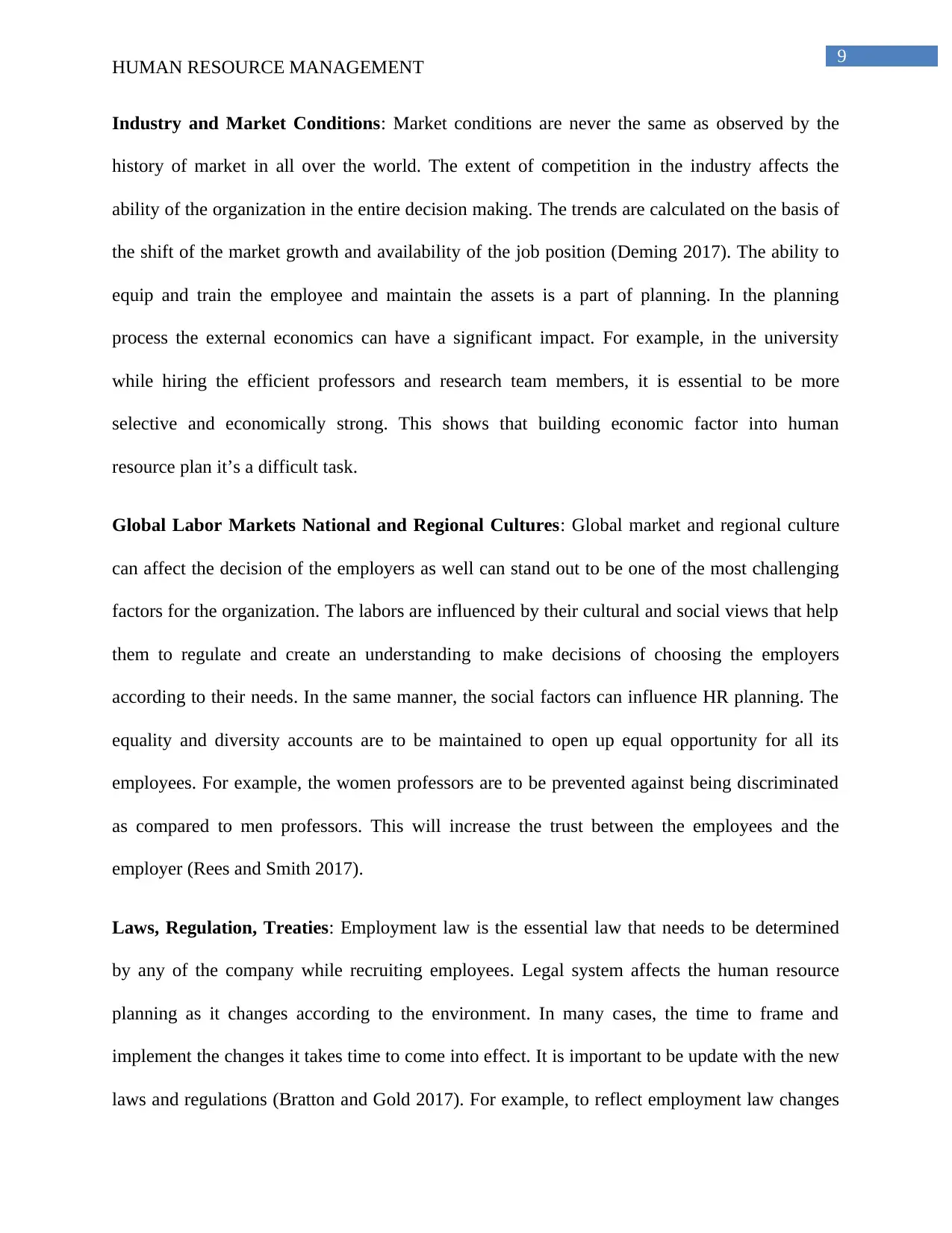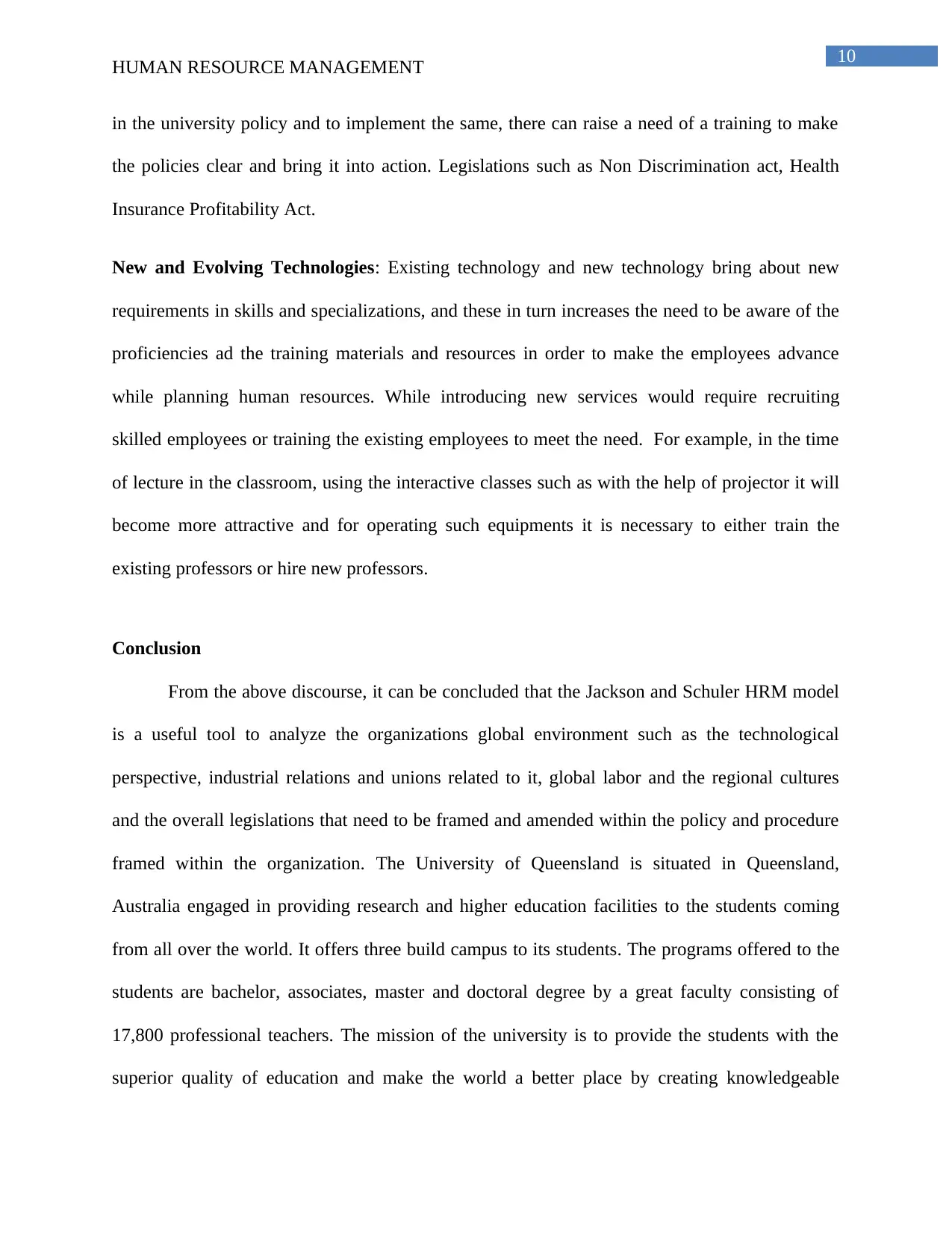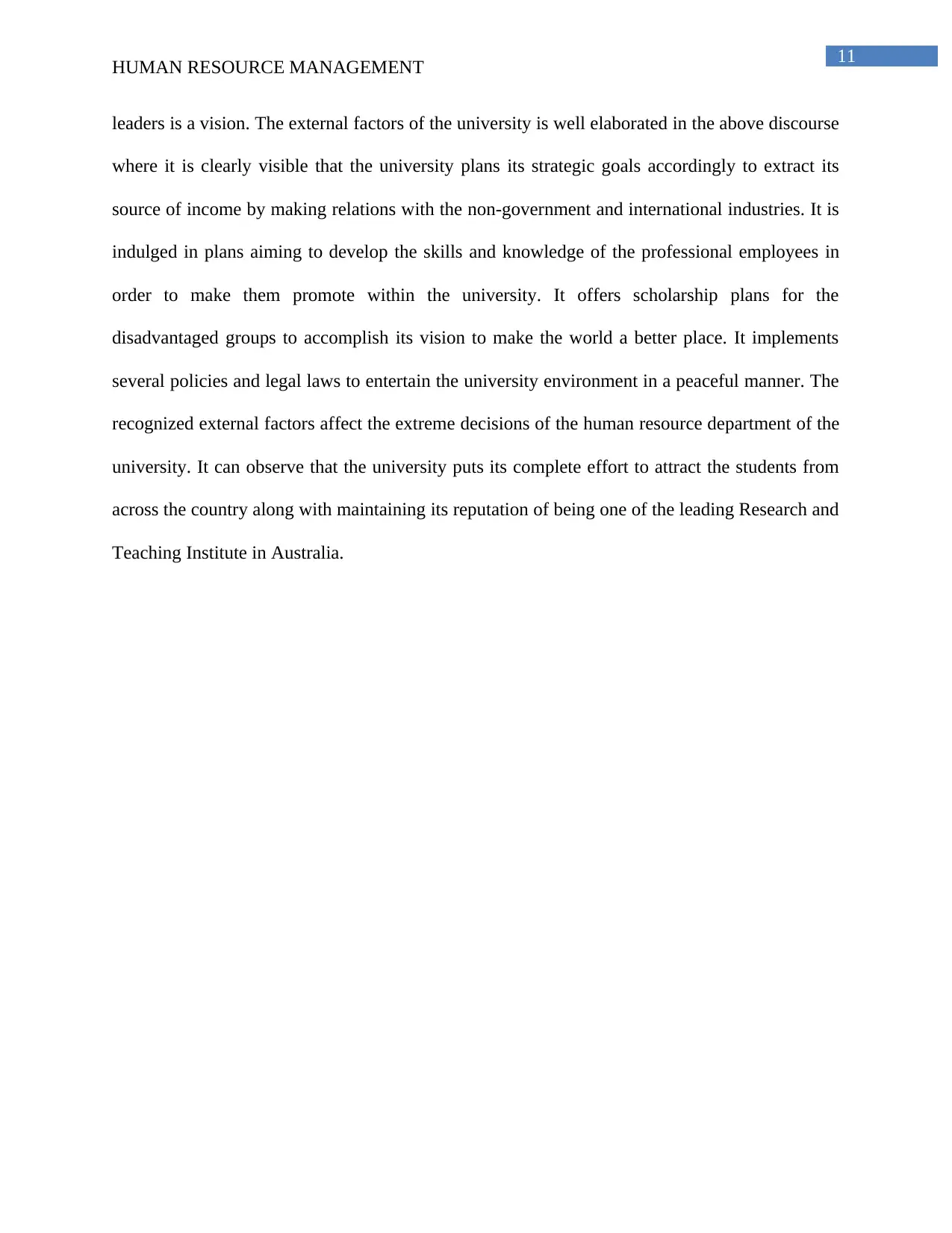External Factors and HRM: A Case Study of University of Queensland
VerifiedAdded on 2021/04/17
|14
|3533
|103
Report
AI Summary
This report provides an in-depth analysis of Human Resource Management (HRM) practices at the University of Queensland (UQ), focusing on the application of the Jackson and Schuler model. The report begins with an introduction to UQ, its mission, vision, and values, setting the context for the HRM analysis. It then delves into the external factors influencing HRM decisions, including industrial relations, market conditions, global labor markets, national and regional cultures, laws, regulations, treaties, and new technologies. The report examines how these factors impact UQ's strategic plans, particularly in areas like funding, recruitment, and technological advancements. Furthermore, the report explores core HRM functions such as planning, resourcing, recruitment, selection, training, development, and remuneration, illustrating how these are implemented within UQ. By examining these functions, the report provides a comprehensive overview of HRM at UQ and how external factors shape its practices.

Running head: HUMAN RESOURCE MANAGEMENT
Human Resource Management
Name of the Student
Name of the University
Author Note
Human Resource Management
Name of the Student
Name of the University
Author Note
Paraphrase This Document
Need a fresh take? Get an instant paraphrase of this document with our AI Paraphraser

1
HUMAN RESOURCE MANAGEMENT
Introduction
The purpose of the essay is to understand the Jackson and Schuler theory and analyze it
with the chosen higher education organization. It also focuses to understand the functions of
human resource management such as planning, resourcing selection and recruitment, training
and development and maintaining employee relations in the organization. The chosen HE
provider is University of Queensland situated in Brisbane in Australia. The university is a
research and teaching institution with three beautiful campuses in South East Queensland named
as St. Lucia, Herston and Gatton. The selected organization was founded in the year 1909. It is
one of the leading universities which offer bachelor, associate ad master and other specialization
programme. The mission of the organization and the vision of the organization are to make the
world a better place by developing the leaders of the future generation full of knowledge. The
essay below will highlight the external factors of the organization as per the HRM model of
Jackson and Schuler the global environment categorizing several other factors such as industrial
relations, market condition, technology and legislation that affects the HRM decisions making in
an organization. After reading the essay, it will be clear that how the Jackson and Schuler model
proposed in 1905 affects the various decisions that take place in the University. The legislation
such as non discrimination act, industrial relations and unions, the industry market trends, global
labor market and regional culture that affect the employee hiring process, and the new and
evolving technologies together combine to become external factors. These external factors
contribute in the decision making of the organization.
HUMAN RESOURCE MANAGEMENT
Introduction
The purpose of the essay is to understand the Jackson and Schuler theory and analyze it
with the chosen higher education organization. It also focuses to understand the functions of
human resource management such as planning, resourcing selection and recruitment, training
and development and maintaining employee relations in the organization. The chosen HE
provider is University of Queensland situated in Brisbane in Australia. The university is a
research and teaching institution with three beautiful campuses in South East Queensland named
as St. Lucia, Herston and Gatton. The selected organization was founded in the year 1909. It is
one of the leading universities which offer bachelor, associate ad master and other specialization
programme. The mission of the organization and the vision of the organization are to make the
world a better place by developing the leaders of the future generation full of knowledge. The
essay below will highlight the external factors of the organization as per the HRM model of
Jackson and Schuler the global environment categorizing several other factors such as industrial
relations, market condition, technology and legislation that affects the HRM decisions making in
an organization. After reading the essay, it will be clear that how the Jackson and Schuler model
proposed in 1905 affects the various decisions that take place in the University. The legislation
such as non discrimination act, industrial relations and unions, the industry market trends, global
labor market and regional culture that affect the employee hiring process, and the new and
evolving technologies together combine to become external factors. These external factors
contribute in the decision making of the organization.

2
HUMAN RESOURCE MANAGEMENT
Part 1
The chosen Higher Education (HE) provider is the University of Queensland (UQ),
situated at Brisbane, Queensland, Australia (Queensland 2018). It is one of the leading
universities among the world’s top universities. The university consists of programs of associate,
bachelor, master and doctoral degrees through a college, a graduate school and six faculties with
a wide range of subjects. It is mainly a research and teaching institutions and was founded in
1909 by the state parliament. The UQ has 3 campuses namely, St Lucia, Herston and Gatton.
Students are from all over the world with an approx number of 141 different countries, are a part
of the university. It operates with six faculties and 8 globally recognized research institutes and
research centers with more than 1500 scientists and engineers. The university consists of more
than 17,800 academic and professional employees with an operating budget of $1.8 billion each
year. Their alumni expand to 170 countries (About.uq.edu.au 2018).
The university’s mission and vision contributes for the future strategies, and in the
making of the decision and activities. The policies and procedures are framed accordingly to
implement the strategic plan ensuring the right activities with the added value and effort. It also
states a purpose and a commitment from the institution side offered to its students to make them
completely prepare for driving the leadership of the future successfully.
The mission of the university states the three purpose of an organization as stating that
UQ utilizes the excellence of creation, preservation, transfer and application of knowledge to
influence the society and shape the future, and inspire the new generation in order to develop
their skills and ideas to benefit the world and build them the leaders of tomorrow. The university
accomplishes vision to make the world a place where the leaders are filled with adequate
knowledge to make the world a better place. The statement aligns with the strategic decisions of
HUMAN RESOURCE MANAGEMENT
Part 1
The chosen Higher Education (HE) provider is the University of Queensland (UQ),
situated at Brisbane, Queensland, Australia (Queensland 2018). It is one of the leading
universities among the world’s top universities. The university consists of programs of associate,
bachelor, master and doctoral degrees through a college, a graduate school and six faculties with
a wide range of subjects. It is mainly a research and teaching institutions and was founded in
1909 by the state parliament. The UQ has 3 campuses namely, St Lucia, Herston and Gatton.
Students are from all over the world with an approx number of 141 different countries, are a part
of the university. It operates with six faculties and 8 globally recognized research institutes and
research centers with more than 1500 scientists and engineers. The university consists of more
than 17,800 academic and professional employees with an operating budget of $1.8 billion each
year. Their alumni expand to 170 countries (About.uq.edu.au 2018).
The university’s mission and vision contributes for the future strategies, and in the
making of the decision and activities. The policies and procedures are framed accordingly to
implement the strategic plan ensuring the right activities with the added value and effort. It also
states a purpose and a commitment from the institution side offered to its students to make them
completely prepare for driving the leadership of the future successfully.
The mission of the university states the three purpose of an organization as stating that
UQ utilizes the excellence of creation, preservation, transfer and application of knowledge to
influence the society and shape the future, and inspire the new generation in order to develop
their skills and ideas to benefit the world and build them the leaders of tomorrow. The university
accomplishes vision to make the world a place where the leaders are filled with adequate
knowledge to make the world a better place. The statement aligns with the strategic decisions of
⊘ This is a preview!⊘
Do you want full access?
Subscribe today to unlock all pages.

Trusted by 1+ million students worldwide

3
HUMAN RESOURCE MANAGEMENT
the university. The intention of this vision is carried forward to serve through current and future
action of the institution.
The UQ ensures to apply highest standards in its value and actions to benefit the
community and pursuit excellence. The university adds into its values to support the people by
ensuring their safety and wellbeing and providing equal opportunity to the people and with time
recognizing and rewarding them with the achievements. Promoting diversity in ideas and among
cultures to create vibrant environment for the future generation and respect for the work and
among the people. The university encourages innovation and opportunities supporting freedom
and creativity. The decisions are in accordance with ethical standards.
Part 2
Industrial Relations and Unions: It is an important factor that affects the organization as it
reviews the industrial relations and the union that stand regarding any decisions such as labor
unions demanding healthcare facility from the employers. Employment relations are often
framed accurately in the form of policies and procedures which simply states the practices in any
country with the drivers who shape the relations are the employees, employers, unions and
governmental body (Schuler and Jackson 2014).
Industry and Market Conditions: Industry and market condition indicate the necessary
decisions that are taken by the organization related to its industrial and other competitor’s market
situation. Some laws and regulations are mandate for every particular industry which regulates to
all the organizations operating in the same. Market condition can be considered as the rate of
competitiveness, the competitors, growth rate and the market trends in order to meet the product
line.
HUMAN RESOURCE MANAGEMENT
the university. The intention of this vision is carried forward to serve through current and future
action of the institution.
The UQ ensures to apply highest standards in its value and actions to benefit the
community and pursuit excellence. The university adds into its values to support the people by
ensuring their safety and wellbeing and providing equal opportunity to the people and with time
recognizing and rewarding them with the achievements. Promoting diversity in ideas and among
cultures to create vibrant environment for the future generation and respect for the work and
among the people. The university encourages innovation and opportunities supporting freedom
and creativity. The decisions are in accordance with ethical standards.
Part 2
Industrial Relations and Unions: It is an important factor that affects the organization as it
reviews the industrial relations and the union that stand regarding any decisions such as labor
unions demanding healthcare facility from the employers. Employment relations are often
framed accurately in the form of policies and procedures which simply states the practices in any
country with the drivers who shape the relations are the employees, employers, unions and
governmental body (Schuler and Jackson 2014).
Industry and Market Conditions: Industry and market condition indicate the necessary
decisions that are taken by the organization related to its industrial and other competitor’s market
situation. Some laws and regulations are mandate for every particular industry which regulates to
all the organizations operating in the same. Market condition can be considered as the rate of
competitiveness, the competitors, growth rate and the market trends in order to meet the product
line.
Paraphrase This Document
Need a fresh take? Get an instant paraphrase of this document with our AI Paraphraser

4
HUMAN RESOURCE MANAGEMENT
Global Labor Markets National and Regional Cultures: It is an important factor that
regulates the industry and the organization operating in it. The global factors affect the
employment perspective and the challenge that comes out is the employers present everywhere.
The main reason that supports the organization is the national and the regional employers who
are mostly influenced by varied of cultures they come from. The market analysis gives overall
information about the cost of labor in the market and the availability of the same (Cascio 2018).
For the employers handling and managing a long source of process to hire the skillful labor as
per the requirement and after the fulfillment of the labor market trends becomes a challenge
itself.
Laws, Regulation, Treaties: Laws and regulations affect an organization by all the perspectives
that somehow affect the organizational decisions and the activities taking place within the
organization. The company operating in the market has to follow certain laws and regulations
along with the treaties to maintain their relationship with the other company and the industrial
relations are affected by the same.
New and Evolving Technologies: This indicates the technology being introduced in the industry
by any of the existing or new organization that affects the overall industry and creates
competitive advantage for the introducing company of technology. The rapid development and
influence of technology, increase competition resulting into greater impact in the economic,
political and workforce section related to the industry.
HUMAN RESOURCE MANAGEMENT
Global Labor Markets National and Regional Cultures: It is an important factor that
regulates the industry and the organization operating in it. The global factors affect the
employment perspective and the challenge that comes out is the employers present everywhere.
The main reason that supports the organization is the national and the regional employers who
are mostly influenced by varied of cultures they come from. The market analysis gives overall
information about the cost of labor in the market and the availability of the same (Cascio 2018).
For the employers handling and managing a long source of process to hire the skillful labor as
per the requirement and after the fulfillment of the labor market trends becomes a challenge
itself.
Laws, Regulation, Treaties: Laws and regulations affect an organization by all the perspectives
that somehow affect the organizational decisions and the activities taking place within the
organization. The company operating in the market has to follow certain laws and regulations
along with the treaties to maintain their relationship with the other company and the industrial
relations are affected by the same.
New and Evolving Technologies: This indicates the technology being introduced in the industry
by any of the existing or new organization that affects the overall industry and creates
competitive advantage for the introducing company of technology. The rapid development and
influence of technology, increase competition resulting into greater impact in the economic,
political and workforce section related to the industry.

5
HUMAN RESOURCE MANAGEMENT
Part 3
Industrial Relations and Unions: The university has a strategic plan to increase its funding
from the industry including, government and wider community to engage. It also commits to
increase its source of funding from the non-government industry and international industry as
well. In order to build philanthropic support to attract the student support success, transforming
teaching and learning and the discovery impact. Provides with the designing framework of
Professional Services Capability that supports developing, recognizing, rewarding of the high
performance among the staff. It aligned its scholarship programs such that a wide number of
students are attracted through enriched learning and experiences.
Industry and Market Conditions: The University aims to increase its revenue from the
international students. They will focus on diversifying the source of countries by engaging to
partnership, recruitment and engagement in the emerging markets like Indonesia. This will lead
to effective use of Special Studies Program (SSP). It also plans to create a strong presence in the
developing countries to hold the market. The university ensures that the responsive of operations
and professional services are to be built with a similar culture of UQ to provide high quality. It
enhances its facilities and resources with the ability to invest in the same.
Global Labor Markets National and Regional Cultures: Ensuring the external engagement
measures to recruit the academic skillful employees, appraisal and promotion processes. In order
to achieve the strategic goals the HR department of the university offers to provide the capacity
and the capability of the workforce by strengthening the skills of analytical, advisory and digital
of the employees. To increase the support for collaborations the connectors and facilitators are
partnered. The university also considers student recruitment, enrolment and support. It provides
with reward mechanisms for high performance staff to keep the potential employees within the
HUMAN RESOURCE MANAGEMENT
Part 3
Industrial Relations and Unions: The university has a strategic plan to increase its funding
from the industry including, government and wider community to engage. It also commits to
increase its source of funding from the non-government industry and international industry as
well. In order to build philanthropic support to attract the student support success, transforming
teaching and learning and the discovery impact. Provides with the designing framework of
Professional Services Capability that supports developing, recognizing, rewarding of the high
performance among the staff. It aligned its scholarship programs such that a wide number of
students are attracted through enriched learning and experiences.
Industry and Market Conditions: The University aims to increase its revenue from the
international students. They will focus on diversifying the source of countries by engaging to
partnership, recruitment and engagement in the emerging markets like Indonesia. This will lead
to effective use of Special Studies Program (SSP). It also plans to create a strong presence in the
developing countries to hold the market. The university ensures that the responsive of operations
and professional services are to be built with a similar culture of UQ to provide high quality. It
enhances its facilities and resources with the ability to invest in the same.
Global Labor Markets National and Regional Cultures: Ensuring the external engagement
measures to recruit the academic skillful employees, appraisal and promotion processes. In order
to achieve the strategic goals the HR department of the university offers to provide the capacity
and the capability of the workforce by strengthening the skills of analytical, advisory and digital
of the employees. To increase the support for collaborations the connectors and facilitators are
partnered. The university also considers student recruitment, enrolment and support. It provides
with reward mechanisms for high performance staff to keep the potential employees within the
⊘ This is a preview!⊘
Do you want full access?
Subscribe today to unlock all pages.

Trusted by 1+ million students worldwide

6
HUMAN RESOURCE MANAGEMENT
organization process. It encourages staff by conference attending and providing opportunities to
boost their skills.
Laws, Regulation, Treaties: The University focuses to implement and improve the integration
of different functions across the research lifecycle including the funding, data management and
ethics within the University. The operation of the university includes policy and development
framing, considering strategy to improve its operations, legal services to ensure the operations
are agile. It ensures a gender pay equity framework for pay negotiations along with introducing
diversity in the University for a Flexible Employment Environment. It supports to develop and
implement a Reconciliation Action Plan to create respectful relationships within the university. It
also offers endowment fund for the socioeconomically disadvantaged and remote backgrounds to
help them.
New and Evolving Technologies: The University enhances its IT governance in order to make
sure that the information technology of the university aligns with the strategies and high quality
perspective of the university. Technology is used to strengthen the curriculum, pedagogical and
assessment renewal. With the aim to improve the effectiveness and the efficiency of the student
experience the review of delivery model is enhanced for providing student services and
administration. It believes in providing the student with the best experience to enhance the skills
of the student such as a student hub for new formal and informal teaching and learning spaces. It
also invests in the digitization and active learning delivery process to develop technical and
professional skills (About.uq.edu.au 2018).
Part 4
The typical HR functions are:
HUMAN RESOURCE MANAGEMENT
organization process. It encourages staff by conference attending and providing opportunities to
boost their skills.
Laws, Regulation, Treaties: The University focuses to implement and improve the integration
of different functions across the research lifecycle including the funding, data management and
ethics within the University. The operation of the university includes policy and development
framing, considering strategy to improve its operations, legal services to ensure the operations
are agile. It ensures a gender pay equity framework for pay negotiations along with introducing
diversity in the University for a Flexible Employment Environment. It supports to develop and
implement a Reconciliation Action Plan to create respectful relationships within the university. It
also offers endowment fund for the socioeconomically disadvantaged and remote backgrounds to
help them.
New and Evolving Technologies: The University enhances its IT governance in order to make
sure that the information technology of the university aligns with the strategies and high quality
perspective of the university. Technology is used to strengthen the curriculum, pedagogical and
assessment renewal. With the aim to improve the effectiveness and the efficiency of the student
experience the review of delivery model is enhanced for providing student services and
administration. It believes in providing the student with the best experience to enhance the skills
of the student such as a student hub for new formal and informal teaching and learning spaces. It
also invests in the digitization and active learning delivery process to develop technical and
professional skills (About.uq.edu.au 2018).
Part 4
The typical HR functions are:
Paraphrase This Document
Need a fresh take? Get an instant paraphrase of this document with our AI Paraphraser

7
HUMAN RESOURCE MANAGEMENT
Planning, resourcing and retention: The planning, resourcing and retention strategies
undertaken by the HR are performed in order to plan the manpower of the organization and
divide the work to each of the employees as per the job specification and the skill required.
Implementing effective retention strategies can help the HR to function and organize the
employees to work and perform effectively and efficiently. Retention strategies help to retain the
potential employees from the organization (Paauwe and Farndale 2017).
Recruitment and selection: This is an essential function of the human resource development
which primarily focuses on the betterment of the organization and increases the sales revenue
and affects the product margin of the company. The workforce of the organization is relatively
chosen by this process and is responsible to recruit and select the right people for the right job
with the right skill. Recruitment is done on the basis of the required skill and according to the job
description.
Training and development: Training and development is a function that is performed by the
HR department in order to facilitate the facility and its staff according to the present requirement
of the market (Pollock, Jefferson and Wick 2015). This includes approaching with several
sufficient training programs that enable the employees to the way of advancement which will
benefit to achieve the organization goals. The trainings can be based on the technology
advancement, management strategy advancement or for the development of the employees in a
particular skill.
Remuneration and rewards: Employee remuneration is offered to each of the employees of the
organization to compensate and give rewards for the work performance of the employees. it is
provided and design in a way which can attract employees to perform their specific job
HUMAN RESOURCE MANAGEMENT
Planning, resourcing and retention: The planning, resourcing and retention strategies
undertaken by the HR are performed in order to plan the manpower of the organization and
divide the work to each of the employees as per the job specification and the skill required.
Implementing effective retention strategies can help the HR to function and organize the
employees to work and perform effectively and efficiently. Retention strategies help to retain the
potential employees from the organization (Paauwe and Farndale 2017).
Recruitment and selection: This is an essential function of the human resource development
which primarily focuses on the betterment of the organization and increases the sales revenue
and affects the product margin of the company. The workforce of the organization is relatively
chosen by this process and is responsible to recruit and select the right people for the right job
with the right skill. Recruitment is done on the basis of the required skill and according to the job
description.
Training and development: Training and development is a function that is performed by the
HR department in order to facilitate the facility and its staff according to the present requirement
of the market (Pollock, Jefferson and Wick 2015). This includes approaching with several
sufficient training programs that enable the employees to the way of advancement which will
benefit to achieve the organization goals. The trainings can be based on the technology
advancement, management strategy advancement or for the development of the employees in a
particular skill.
Remuneration and rewards: Employee remuneration is offered to each of the employees of the
organization to compensate and give rewards for the work performance of the employees. it is
provided and design in a way which can attract employees to perform their specific job

8
HUMAN RESOURCE MANAGEMENT
efficiently and effectively. HR focuses on this function to provide the employees towards
motivation. Remuneration is a source of income and standard of living for the working
employees and affects the productivity and performance of the employees. The methods of
remuneration are based upon the companies that affect the working condition of both employee
and management.
Employee relations: the typical function of HR is to manage employee relations. It is important
to maintain an effective and healthy relationship with the employees in order to establish trust
and confidence within the organization (Butler and Callahan 2014). In case of any conflict or
misunderstanding between the employees or with the managers or simply any dispute within the
organization, it is the duty of the human resource department to intervene the situation. The job
of maintaining the employee relations in the organization ensure the smooth operations to run in
the management.
Part 5
Industrial Relations and Unions: Industrial relations can also be termed as internal policies and
procedures that impact the HR activities. For example, the university if is committed to promote
the teaching staff, in that case to ensure the employees it is necessary to provide them with the
essential training and development programme to make them eligible of promotion. As the
university is unionized with respect to formed by the students union, the HR of the university has
to engage for the collective bargaining on matters which is presented in order to solve and make
better decision on the same. The change in government can enable to a new administration and
relation to markets and industries.
HUMAN RESOURCE MANAGEMENT
efficiently and effectively. HR focuses on this function to provide the employees towards
motivation. Remuneration is a source of income and standard of living for the working
employees and affects the productivity and performance of the employees. The methods of
remuneration are based upon the companies that affect the working condition of both employee
and management.
Employee relations: the typical function of HR is to manage employee relations. It is important
to maintain an effective and healthy relationship with the employees in order to establish trust
and confidence within the organization (Butler and Callahan 2014). In case of any conflict or
misunderstanding between the employees or with the managers or simply any dispute within the
organization, it is the duty of the human resource department to intervene the situation. The job
of maintaining the employee relations in the organization ensure the smooth operations to run in
the management.
Part 5
Industrial Relations and Unions: Industrial relations can also be termed as internal policies and
procedures that impact the HR activities. For example, the university if is committed to promote
the teaching staff, in that case to ensure the employees it is necessary to provide them with the
essential training and development programme to make them eligible of promotion. As the
university is unionized with respect to formed by the students union, the HR of the university has
to engage for the collective bargaining on matters which is presented in order to solve and make
better decision on the same. The change in government can enable to a new administration and
relation to markets and industries.
⊘ This is a preview!⊘
Do you want full access?
Subscribe today to unlock all pages.

Trusted by 1+ million students worldwide

9
HUMAN RESOURCE MANAGEMENT
Industry and Market Conditions: Market conditions are never the same as observed by the
history of market in all over the world. The extent of competition in the industry affects the
ability of the organization in the entire decision making. The trends are calculated on the basis of
the shift of the market growth and availability of the job position (Deming 2017). The ability to
equip and train the employee and maintain the assets is a part of planning. In the planning
process the external economics can have a significant impact. For example, in the university
while hiring the efficient professors and research team members, it is essential to be more
selective and economically strong. This shows that building economic factor into human
resource plan it’s a difficult task.
Global Labor Markets National and Regional Cultures: Global market and regional culture
can affect the decision of the employers as well can stand out to be one of the most challenging
factors for the organization. The labors are influenced by their cultural and social views that help
them to regulate and create an understanding to make decisions of choosing the employers
according to their needs. In the same manner, the social factors can influence HR planning. The
equality and diversity accounts are to be maintained to open up equal opportunity for all its
employees. For example, the women professors are to be prevented against being discriminated
as compared to men professors. This will increase the trust between the employees and the
employer (Rees and Smith 2017).
Laws, Regulation, Treaties: Employment law is the essential law that needs to be determined
by any of the company while recruiting employees. Legal system affects the human resource
planning as it changes according to the environment. In many cases, the time to frame and
implement the changes it takes time to come into effect. It is important to be update with the new
laws and regulations (Bratton and Gold 2017). For example, to reflect employment law changes
HUMAN RESOURCE MANAGEMENT
Industry and Market Conditions: Market conditions are never the same as observed by the
history of market in all over the world. The extent of competition in the industry affects the
ability of the organization in the entire decision making. The trends are calculated on the basis of
the shift of the market growth and availability of the job position (Deming 2017). The ability to
equip and train the employee and maintain the assets is a part of planning. In the planning
process the external economics can have a significant impact. For example, in the university
while hiring the efficient professors and research team members, it is essential to be more
selective and economically strong. This shows that building economic factor into human
resource plan it’s a difficult task.
Global Labor Markets National and Regional Cultures: Global market and regional culture
can affect the decision of the employers as well can stand out to be one of the most challenging
factors for the organization. The labors are influenced by their cultural and social views that help
them to regulate and create an understanding to make decisions of choosing the employers
according to their needs. In the same manner, the social factors can influence HR planning. The
equality and diversity accounts are to be maintained to open up equal opportunity for all its
employees. For example, the women professors are to be prevented against being discriminated
as compared to men professors. This will increase the trust between the employees and the
employer (Rees and Smith 2017).
Laws, Regulation, Treaties: Employment law is the essential law that needs to be determined
by any of the company while recruiting employees. Legal system affects the human resource
planning as it changes according to the environment. In many cases, the time to frame and
implement the changes it takes time to come into effect. It is important to be update with the new
laws and regulations (Bratton and Gold 2017). For example, to reflect employment law changes
Paraphrase This Document
Need a fresh take? Get an instant paraphrase of this document with our AI Paraphraser

10
HUMAN RESOURCE MANAGEMENT
in the university policy and to implement the same, there can raise a need of a training to make
the policies clear and bring it into action. Legislations such as Non Discrimination act, Health
Insurance Profitability Act.
New and Evolving Technologies: Existing technology and new technology bring about new
requirements in skills and specializations, and these in turn increases the need to be aware of the
proficiencies ad the training materials and resources in order to make the employees advance
while planning human resources. While introducing new services would require recruiting
skilled employees or training the existing employees to meet the need. For example, in the time
of lecture in the classroom, using the interactive classes such as with the help of projector it will
become more attractive and for operating such equipments it is necessary to either train the
existing professors or hire new professors.
Conclusion
From the above discourse, it can be concluded that the Jackson and Schuler HRM model
is a useful tool to analyze the organizations global environment such as the technological
perspective, industrial relations and unions related to it, global labor and the regional cultures
and the overall legislations that need to be framed and amended within the policy and procedure
framed within the organization. The University of Queensland is situated in Queensland,
Australia engaged in providing research and higher education facilities to the students coming
from all over the world. It offers three build campus to its students. The programs offered to the
students are bachelor, associates, master and doctoral degree by a great faculty consisting of
17,800 professional teachers. The mission of the university is to provide the students with the
superior quality of education and make the world a better place by creating knowledgeable
HUMAN RESOURCE MANAGEMENT
in the university policy and to implement the same, there can raise a need of a training to make
the policies clear and bring it into action. Legislations such as Non Discrimination act, Health
Insurance Profitability Act.
New and Evolving Technologies: Existing technology and new technology bring about new
requirements in skills and specializations, and these in turn increases the need to be aware of the
proficiencies ad the training materials and resources in order to make the employees advance
while planning human resources. While introducing new services would require recruiting
skilled employees or training the existing employees to meet the need. For example, in the time
of lecture in the classroom, using the interactive classes such as with the help of projector it will
become more attractive and for operating such equipments it is necessary to either train the
existing professors or hire new professors.
Conclusion
From the above discourse, it can be concluded that the Jackson and Schuler HRM model
is a useful tool to analyze the organizations global environment such as the technological
perspective, industrial relations and unions related to it, global labor and the regional cultures
and the overall legislations that need to be framed and amended within the policy and procedure
framed within the organization. The University of Queensland is situated in Queensland,
Australia engaged in providing research and higher education facilities to the students coming
from all over the world. It offers three build campus to its students. The programs offered to the
students are bachelor, associates, master and doctoral degree by a great faculty consisting of
17,800 professional teachers. The mission of the university is to provide the students with the
superior quality of education and make the world a better place by creating knowledgeable

11
HUMAN RESOURCE MANAGEMENT
leaders is a vision. The external factors of the university is well elaborated in the above discourse
where it is clearly visible that the university plans its strategic goals accordingly to extract its
source of income by making relations with the non-government and international industries. It is
indulged in plans aiming to develop the skills and knowledge of the professional employees in
order to make them promote within the university. It offers scholarship plans for the
disadvantaged groups to accomplish its vision to make the world a better place. It implements
several policies and legal laws to entertain the university environment in a peaceful manner. The
recognized external factors affect the extreme decisions of the human resource department of the
university. It can observe that the university puts its complete effort to attract the students from
across the country along with maintaining its reputation of being one of the leading Research and
Teaching Institute in Australia.
HUMAN RESOURCE MANAGEMENT
leaders is a vision. The external factors of the university is well elaborated in the above discourse
where it is clearly visible that the university plans its strategic goals accordingly to extract its
source of income by making relations with the non-government and international industries. It is
indulged in plans aiming to develop the skills and knowledge of the professional employees in
order to make them promote within the university. It offers scholarship plans for the
disadvantaged groups to accomplish its vision to make the world a better place. It implements
several policies and legal laws to entertain the university environment in a peaceful manner. The
recognized external factors affect the extreme decisions of the human resource department of the
university. It can observe that the university puts its complete effort to attract the students from
across the country along with maintaining its reputation of being one of the leading Research and
Teaching Institute in Australia.
⊘ This is a preview!⊘
Do you want full access?
Subscribe today to unlock all pages.

Trusted by 1+ million students worldwide
1 out of 14
Your All-in-One AI-Powered Toolkit for Academic Success.
+13062052269
info@desklib.com
Available 24*7 on WhatsApp / Email
![[object Object]](/_next/static/media/star-bottom.7253800d.svg)
Unlock your academic potential
Copyright © 2020–2025 A2Z Services. All Rights Reserved. Developed and managed by ZUCOL.